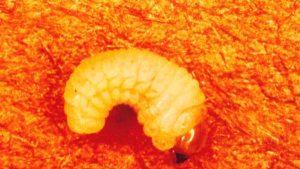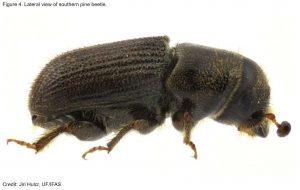Southern pine beetle, a bark beetle species, occupies the forest areas of the southern parts of the United States, Central America, and Mexico. They mostly dwell in the pine tree’s inner bark; that is how it has attained its name.
Size: 2 – 4 mm (0.07 – 0.15 inches)
Color: Their hard exoskeleton has a reddish-brown or black coloration.
Other Characteristic Features: Some of their prominent physical features include a cylindrical body, round legs, and a short abdomen. This species exhibits sexual dimorphism. The males have an indented pattern on the front part of their head, absent in the females. On the other hand, the female species have a raised transverse ridge with increased width.
They have a white crescent-shaped body and a caramel head. Initially, they have a length of 2 mm (0.07 inches) that eventually increases to 7 mm (0.27 inches) as they grow. When they reach the fourth and last instar stage, the grubs create cells within the trees’ barks where they can stay during the pupal phase.

They are of a similar size and color as the adults, and the pupal phase lasts for 5 to 17 days. At the end of this stage, the callow or immature adults appear yellowish-white, ad gradually attain their actual color.
They are round or oval with a pearly white body mostly spotted in galleries within the pine tree’s inner bark.
| Adult Lifespan | 6 – 14 days |
| Larval stage duration | 7 – 13 days |
| Distribution | Southeastern parts of the United States covering the states of Texas, Illinois, New Jersey, and Florida, alongcol3 Central America, and Mexico |
| Habitat | In the forest areas near pine trees |
| Common Predators | Mites, and insects |
| Seasons active from | March – July |
| Host Plants | United States: Loblolly pine, shortleaf pine, slash pine, Virginia pine, pitch pine, longleaf pine, pond pine, hickory pine, Apache pine, yellow pine Central America: Caribbean pine, thinleaf pine, ocote chino |
| Diet of larvae and adults | Phloem tissues beneath the barks of their host plants |

They mostly attack the pines that have been stressed or weakened by winds, drought, or storms. The adults mostly attack the middle or lower trunks of the pine trees, destroying them while feeding upon the phloem. The galleries within the bark are S-shaped, responsible for wearing the tree down and resulting in its death.
Image Source: barkbeetles.org, ipmsouth.files.wordpress.com, barkbeetles.org, bugguide.net
Southern pine beetle, a bark beetle species, occupies the forest areas of the southern parts of the United States, Central America, and Mexico. They mostly dwell in the pine tree’s inner bark; that is how it has attained its name.
Size: 2 – 4 mm (0.07 – 0.15 inches)
Color: Their hard exoskeleton has a reddish-brown or black coloration.
Other Characteristic Features: Some of their prominent physical features include a cylindrical body, round legs, and a short abdomen. This species exhibits sexual dimorphism. The males have an indented pattern on the front part of their head, absent in the females. On the other hand, the female species have a raised transverse ridge with increased width.
They have a white crescent-shaped body and a caramel head. Initially, they have a length of 2 mm (0.07 inches) that eventually increases to 7 mm (0.27 inches) as they grow. When they reach the fourth and last instar stage, the grubs create cells within the trees’ barks where they can stay during the pupal phase.

They are of a similar size and color as the adults, and the pupal phase lasts for 5 to 17 days. At the end of this stage, the callow or immature adults appear yellowish-white, ad gradually attain their actual color.
They are round or oval with a pearly white body mostly spotted in galleries within the pine tree’s inner bark.
| Adult Lifespan | 6 – 14 days |
| Larval stage duration | 7 – 13 days |
| Distribution | Southeastern parts of the United States covering the states of Texas, Illinois, New Jersey, and Florida, alongcol3 Central America, and Mexico |
| Habitat | In the forest areas near pine trees |
| Common Predators | Mites, and insects |
| Seasons active from | March – July |
| Host Plants | United States: Loblolly pine, shortleaf pine, slash pine, Virginia pine, pitch pine, longleaf pine, pond pine, hickory pine, Apache pine, yellow pine Central America: Caribbean pine, thinleaf pine, ocote chino |
| Diet of larvae and adults | Phloem tissues beneath the barks of their host plants |

They mostly attack the pines that have been stressed or weakened by winds, drought, or storms. The adults mostly attack the middle or lower trunks of the pine trees, destroying them while feeding upon the phloem. The galleries within the bark are S-shaped, responsible for wearing the tree down and resulting in its death.
Image Source: barkbeetles.org, ipmsouth.files.wordpress.com, barkbeetles.org, bugguide.net